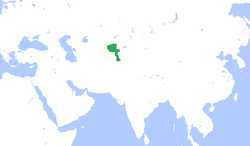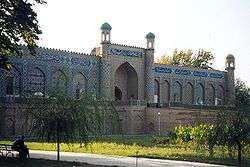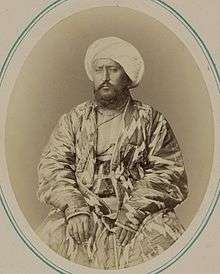Khanate of Kokand
The Khanate of Kokand (Uzbek: Qo‘qon Xonligi; Қўқон Хонлиги, قۇقان خانلىگى; Persian: خانات خوقند, romanized: Xânâte Xuqand) was an Uzbek[1] state in Fergana Valley, Central Asia that existed from 1709–1876 within the territory of eastern Uzbekistan, modern Kyrgyzstan, eastern Tajikistan and southeastern Kazakhstan. The name of the city and the khanate may also be spelled as Khoqand in modern scholarly literature.
Khanate of Kokand خانات خوقند Qo‘qon Xonligi | |||||||||
|---|---|---|---|---|---|---|---|---|---|
| 1709–1876 | |||||||||
 Flag | |||||||||
 The Khanate of Kokand (green), c. 1850. | |||||||||
| Capital | Kokand | ||||||||
| Common languages | Persian[lower-alpha 1][lower-alpha 2][lower-alpha 3] Uzbek | ||||||||
| Religion | Sunni Islam | ||||||||
| Government | Monarchy | ||||||||
| History | |||||||||
• Established | 1709 | ||||||||
• Disestablished | 1876 | ||||||||
| |||||||||
| Today part of | Uzbekistan Kyrgyzstan Tajikistan Kazakhstan | ||||||||

History
The Khanate of Kokand was established in 1709 when the Shaybanid emir Shahrukh, of the Ming Tribe of Uzbeks, declared independence from the Khanate of Bukhara, establishing a state in the eastern part of the Fergana Valley. He built a citadel as his capital in the small town of Kokand, thus starting the Khanate of Kokand. His son, Abdul Kahrim Bey, and grandson, Narbuta Bey, enlarged the citadel, but both were forced to submit as a protectorate, and pay tribute to, the Qing dynasty in China between 1774 and 1798.[2][3]
Narbuta Bey’s son Alim was both ruthless and efficient. He hired a mercenary army of Tajik highlanders, and conquered the western half of the Fergana Valley, including Khujand and Tashkent. He was assassinated by his brother Umar in 1811. Umar’s son, Mohammed Ali (Madali Khan), ascended to the throne in 1822 at the age of 12. During his reign, the Khanate of Kokand reached its greatest territorial extent. The Kokand Khanate also housed the Khojas of Kashgar like Jahangir Khoja. In 1841, the British officer Captain Arthur Conolly failed to persuade the various khanates to put aside their differences, in an attempt to counter the growing penetration of the Russian Empire into the area. In November 1841, Captain Conolly left Kokand for Bukhara in an ill-fated attempt to rescue fellow officer Colonel Charles Stoddart, and both were executed on 24 June 1842 by the order of Emir Nasrullah Khan of Bukhara.[4][2]
Following this, Madali Khan, who had received Conolly in Kokand, and who had also sought an alliance with Russia, lost the trust of Nasrullah. The Emir, encouraged by the conspiratorial efforts of several influential figures in Kokand (including the commander in chief of its army), invaded the Khanate in 1842. Shortly thereafter he executed Madali Khan, his brother, and Omar Khan's widow, the famed poet Nodira. Madali Khan’s cousin, Shir Ali, was installed as the Khan of Kokand in June 1842.[5] Over the next two decades, the khanate was weakened by a bitter civil war, which was further exacerbated by Bukharan and Russian incursions. Shir Ali’s son, Khudayar Khan, ruled from 1844 to 1858, from 1862 to 1863, and from 1865 to 1875. In the meantime, Russia was continuing its advance; on 29 June 1865 Tashkent was taken by the Russian troops of General Chernyayev; the loss of Khujand followed in 1867.[6]
Shortly before the fall of Tashkent, Kokand’s best-known son, Yakub Beg, former lord of Tashkent, was sent by the then Khan of Kokand, Alimqul, to Kashgar, where the Hui Muslims were in revolt against the Chinese. When Alimqul was killed in 1865 during the battle with Russia for Tashkent, many Kokandian soldiers fled to join Yaqub Beg, helping him establish his dominion throughout the Tarim Basin, which lasted until 1877, when Qing reconquered the region.[2]
In 1868, a treaty turned Kokand into a Russian vassal state. The now powerless Khudayar Khan spent his energies improving his lavish palace. Western visitors were impressed by the city of 80,000 people, which contained some 600 mosques and 15 madrasahs. Insurrections against Russian rule and Khudayar’s oppressive taxes forced him into exile in 1875. He was succeeded by his son, Nasruddin Khan, whose anti-Russian stance provoked the annexation of Kokand (after six months of fierce fighting) by Generals Konstantin von Kaufman and Mikhail Skobelev. In January 1876, Tsar Alexander II stated that he had been forced to "... yield to the wishes of the Kokandi people to become Russian subjects." The Khanate of Kokand was declared abolished, and incorporated into the Fergana Oblast of Russian Turkestan.
Rulers of Kokand (1709-1876)

| Reign | Ruler |
|---|---|
| 1709 – 1722 | Shahrukh Bey |
| 1722 – 1734 | Abdul Rahim Bey |
| 1734 – 1751 | Abdul Kahrim Bey |
| 1751 – 1752 | Irdana Bey (1st Reign) |
| 1752 – 1753 | Bobobek |
| 1753 – 1769 | Irdana Bey (2nd Reign) |
| 1769 – 1770 | Suleiman Bey |
| 1770 – 1799 | Narbuta Bey |
| 1799 – 1811 | Alim Khan |
| 1811 – 1822 | Muhammad Umar Khan |
| 1822 – 1842 | Muhammad Ali Khan |
| 1842 – 1844 | Shir Ali Khan |
| 1844 | Murad Beg Khan |
| 1844 – 1852 | Muhammad Khudayar Khan (1st Reign) |
| Mingbashi Musulmonqul (Regent for Khudayar Khan) | |
| 1852 – 1858 | Muhammad Khudayar Khan (2nd Reign) |
| 1858 – 1862 | Muhammad Mallya Beg Khan |
| 1862 | Shah Murad Khan |
| 1862 – 1863 | Muhammad Khudayar Khan (3rd Reign) |
| 1863 – 1865 | Muhammad Sultan Khan |
| Alimqul (Regent for Sultan Khan) | |
| 1865 | Bil Bahchi Khan |
| 1865 – 1875 | Muhammad Khudayar Khan (4th Reign) |
| 1875 | Nasruddin Khan (1st Reign) |
| 1875 | Muhammad Pulad Beg Khan |
| 1876 | Nasruddin Khan (2nd Reign) |
See also
- List of Turkic dynasties and countries
- List of Sunni Muslim dynasties
- Emirate of Bukhara
- Khanate of Khiva
Notes
- Roy, p. 3. "...the court language was Persian at Bukhara and Kokand, in other words the language of the Tajiks, which at the time was seen as the main cultured language. The idea of associating a territory with an ethnic group defined by language was alien to the political ideas of the Muslims of Central Asia. These populations were, and still are widely intermingled, so that infra-ethnic identitics (tribal, clan, locality, family, etc) were more important in determining loyalties than strictly ethnic origin."
- Roy, p. 4, "Persian was the language of civilisation par excellence from Delhi to Samarkand, passing via Lahore and Kabul, and this remained the case until the early twentieth century. The emirates of Kokand and Bukhara had Persian as their official language right up to their dissolution (in 1876 and 1920 respectively)"
- History of Civilizations of Central Asia, p. 81.
Citations
- Golden, p. 115.
- Starr.
- OʻzME.
- Howorth, p. 801.
- Dubavitski, pp. 31-33.
- History of Civilizations of Central Asia.
- Bosworth, p. 295.
- Geiss, pp. 116-117.
- Levi, The Rise and Fall of Khoqand, 1709 - 1876, p. XIX.
References
- Beisembiev, T. K. Kokandskaia istoriografiia : Issledovanie po istochnikovedeniiu Srednei Azii XVIII-XIX vekov. Almaty, TOO "PrintS", 2009.ISBN 978-9965-482-84-7.
- Beisembiev, T. K. "Annotated indices to the Kokand Chronicles". Tokyo: Research Institute for Languages and Cultures of Asia and Africa, Tokyo University of Foreign Studies. Studia Culturae Islamica. № 91, 2008.ISBN 978-4-86337-001-2.
- Beisembiev, T. K. "The Life of Alimqul: A Native Chronicle of Nineteenth Century Central Asia". Published 2003. Routledge ISBN 978-0-7007-1114-7.
- Beisembiev, T. K. "Ta'rikh-i SHakhrukhi" kak istoricheskii istochnik. Alma Ata: Nauka, 1987.
- Beisembiev, T. K. "Legenda o proiskhozhdenii kokandskikh khanov kak istochnik po istorii ideologii v Srednei Azii (na materialakh sochinenii kokandskoi istoriografii)". Kazakhstan, Srednjaja i Tsentralnaia Azia v XVI-XVIII vv. Alma-ata, 1983.
- Bosworth, Clifford Edmund (2004). The New Islamic Dynasties: A Chronological and Genealogical Manual. Edinburgh University Press.
- Dubavitski, Victor and Bababekov, Khaydarbek, in S. Frederick Starr, ed., Ferghana Valley: The Heart of Central Asia.
- Erkinov, Aftandil S. "Imitation of Timurids and Pseudo-Legitimation: On the origins of a manuscript anthology of poems dedicated to the Kokand ruler Muhammad Ali Khan (1822–1842)," GSAA Online Working Paper No. 5[1].
- Erkinov, Aftandil S. "Les timourides, modeles de legitimite et les recueils poetiques de Kokand". Ecrit et culture en Asie centrale et dans le monde Turko-iranien, XIVe-XIXe siècles // Writing and Culture in Central Asia and in the Turko-Iranian World, 14th-19th Centuries. F.Richard, M.Szuppe (eds.), [Cahiers de Studia Iranica. 40]. Paris: AAEI, 2009.
- Geiss, Paul Georg (2003). Pre-tsarist and Tsarist Central Asia: Communal Commitment and Political Order in Change. Routledge. Retrieved 19 March 2019.
- Golden, Peter B. (2011), Central Asia in World History, Oxford University Press.
- History of Civilizations of Central Asia. UNESCO. 1 January 2003. ISBN 9789231038761.
- Howorth, Sir Henry Hoyle. History of the Mongols: From the 9th to the 19th Century, Volume 2, Issue 2, pp. 795–801,816-845.
- Levi, Scott C. "Babur’s Legacy and Political Legitimacy in the Khanate of Khoqand." to be submitted to the Journal of Asian Studies.
- Levi, Scott C. (2017). The Rise and Fall of Khoqand, 1709 - 1876: Central Asia in the Global Age. University of Pittsburgh.
- "The Muslim World"; Part III, "The Last Great Muslim Empires": Translation and Adaptations by F.R.C. Bagley. (Originally published 1969). Brill Academic Publishers, ISBN 978-90-04-02104-4.
- Nalivkine, V. P. Histoire du Khanat de Khokand. Trad. A.Dozon. Paris, 1889.
- Nalivkine, V. P. "Kratkaia istoria kokandskogo khanstva". Istoria Srednei Azii. A.I.Buldakov, S.A.Shumov, A.R.Andreev (eds.). Moskva, 2003.
- OʻzME. Birinchi jild. Tashkent, 2000.
- Roy, Olivier. (2007). "The New Central Asia: Geopolitics and the Birth of Nations". I.B.Tauris.
- Starr, S. Frederick (18 December 2014). Ferghana Valley: The Heart of Central Asia. Routledge. ISBN 9781317470663.
- Vakhidov, Sh.Kh. XIX-ХХ asr bāshlarida Qoqān khānligida tarikhnavislikning rivājlanishi. arikh fanlari doktori dissertatsiyasi. Tāshkent, 1998.
